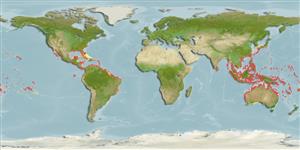Bivalvia |
Myida |
Pholadidae
Environment: milieu / climate zone / depth range / distribution range
Ecology
Benthic; depth range 0 - 21 m (Ref. 104365). Tropical
Circumglobal distribution in temperate and tropical marine waters.
Length at first maturity / Size / Weight / Age
Maturity: Lm ? range ? - ? cm Max length : 5.0 cm SHL male/unsexed; (Ref. 348); common length : 3.5 cm SHL male/unsexed; (Ref. 348)
Found in intertidal areas and shallow water in timber (Ref. 75831). Wood borer (Ref. 104365). Also found boring in PVC plastic (Ref. 75840).
Life cycle and mating behavior
Maturity | Reproduction | Spawning | Eggs | Fecundity | Larvae
Alternating hermaphrodite changing sex with temperature, most individuals becoming female in summer and male in winter. Fertilization external. Free-swimming larval stage of about a month.
Poutiers, J.M. 1998 Bivalves. Acephala, Lamellibranchia, Pelecypoda. p. 123-362. In Carpenter, K. E. and V. H. Niem. 1998. FAO species identification guide for fishery purposes. The living marine resources of the Western Central Pacific. Volume 1. Seaweeds, corals, bivalves, and gastropods. Rome, FAO. (Ref. 348)
IUCN Red List Status
(Ref. 130435: Version 2025-1)
CITES status (Ref. 108899)
Not Evaluated
Not Evaluated
Threat to humans
Human uses
| FishSource |
Tools
More information
Trophic EcologyFood items (preys)
Diet composition
Food consumption
Predators
Population dynamicsGrowthMax. ages / sizesLength-weight rel.Length-length rel.Length-frequenciesMass conversionAbundance Life cycleReproductionMaturityFecunditySpawningEggsEgg developmentLarvae PhysiologyOxygen consumption
Human RelatedStamps, coins, misc.
Internet sources
Estimates based on models
Preferred temperature
(Ref.
115969): 23.3 - 29.2, mean 28 (based on 4327 cells).
Fishing Vulnerability
Low vulnerability (10 of 100).
Price category
Unknown.
